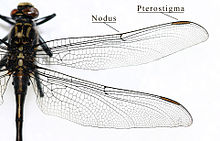Pterothorax
The pterothorax (from the Greek pteron = "wing, feather, fin" and thorax = "breastplate") is the part of the chest section ( thorax ) of the winged insects that carries the wings . It accordingly consists of the second and third breast segments, the meso- and metathorax . In addition to the wings, these chest segments also have the second and third pair of legs , inside the sections are equipped with the flight muscles .
Structure for individual orders
Dragonflies
In dragonflies , the pterothorax has a clear rearward orientation. This is due to the fact that the mesepisterna are fused forward. Where they meet they form the dorsal keel which merges into the antealar ridge backwards. The keel that goes out from there and runs under the wing is especially important with the large forces that arise from the large wings of the dragonflies in order to guarantee stability. Another peculiarity of the dragonflies is that of the meso- and metathorax, which are still separate in the larvae, in which the imago are fused. Along the former borders there are thickenings that give the structure stability. Last but not least, the metepisterna are also fused on the underside behind the legs , as a result of which another keel forms on the posterior lateral edge of the pterothorax. The pterothorax is further divided by three pleurae . The first forms the mesopleura or humeral. The second is the weakly pronounced interpleural furrow that is located between the fused Mes- and Metathorax. Finally, the metapleural groove is located between the mesepisternum and the mesepimeron.
supporting documents
- ↑ a b pterothorax. In: Herder-Lexikon der Biologie. Spektrum Akademischer Verlag, Heidelberg 2003, ISBN 3-8274-0354-5 .
- James George Needham , Minter J. Westfall , Michael L. May : Dragonflies of North America. Scientific Publishers, 2000, ISBN 0-945417-94-2 .

